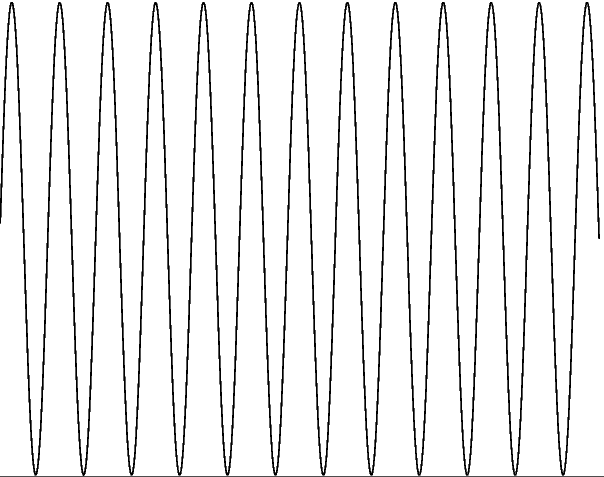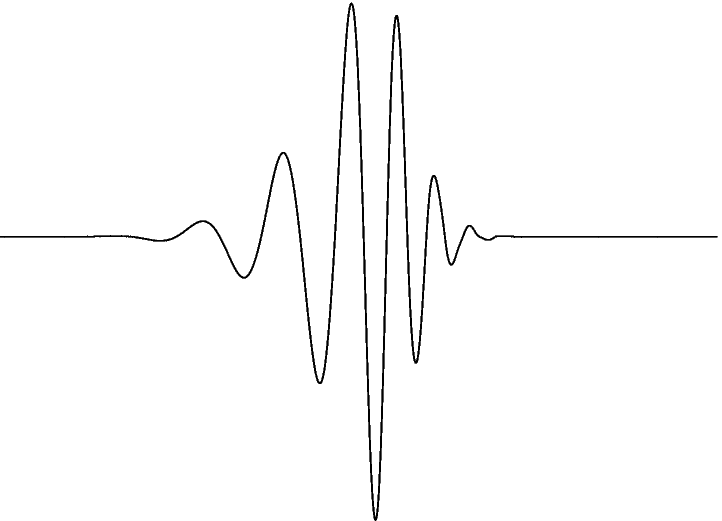2.1. Wavelets and Wavelet Expansion Systems
Before delving into the details of wavelets and their properties, we
need to get some idea of their general characteristics and what we are
going to do with them 11.
What is a Wavelet Expansion or a Wavelet Transform?
A signal or function f(t) can often be better analyzed, described, or
processed if expressed as a linear decomposition by
where ℓ is an integer index for the finite or infinite sum, aℓ are
the real-valued expansion coefficients, and ψℓ(t) are a set of
real-valued functions of t called the expansion set.
If the expansion Equation 2.1 is unique, the set is called a basis
for the class of functions that can be so expressed. If the basis is
orthogonal, meaning
then the coefficients can be calculated by the inner product
One can see that substituting Equation 2.1 into Equation 2.3 and using Equation 2.2
gives the single ak coefficient. If the basis set is not orthogonal,
then a dual basis set  exists such that using Equation 2.3
with the dual basis gives the desired coefficients. This will be developed
in Chapter: A multiresolution formulation of Wavelet Systems.
exists such that using Equation 2.3
with the dual basis gives the desired coefficients. This will be developed
in Chapter: A multiresolution formulation of Wavelet Systems.
For a Fourier series, the orthogonal basis functions ψk(t) are
 and
and  with frequencies of kω0.
For a Taylor's
series, the nonorthogonal basis functions are simple monomials tk, and
for many other expansions they are various polynomials. There are
expansions that use splines and even fractals.
with frequencies of kω0.
For a Taylor's
series, the nonorthogonal basis functions are simple monomials tk, and
for many other expansions they are various polynomials. There are
expansions that use splines and even fractals.
For the wavelet expansion, a two-parameter system is constructed
such that Equation 2.1 becomes
where both j and k are integer indices and the ψj,k(t) are
the wavelet expansion functions that usually form an orthogonal basis.
The set of expansion coefficients aj,k are called the discrete
wavelet transform (DWT) of f(t) and Equation 2.4 is the inverse transform.
What is a Wavelet System?
The wavelet expansion set is not unique. There are many different wavelets
systems that can be used effectively, but all seem to have the following three
general characteristics 11.
A wavelet system is a set of building blocks to construct or
represent a signal or function. It is a two-dimensional expansion set
(usually a basis) for some class of one- (or higher) dimensional
signals. In other words, if the wavelet set is given by ψj,k(t)
for indices of j,k=1,2,⋯, a linear expansion would be
 for some set of coefficients
aj,k.
for some set of coefficients
aj,k.
The wavelet expansion gives a time-frequency localization of the
signal. This means most of the energy of the signal is well represented
by a few expansion coefficients, aj,k.
The calculation of the coefficients from the signal can be done efficiently. It turns out that many wavelet transforms (the set of
expansion coefficients) can calculated with O(N) operations. This means
the number of floating-point multiplications and additions increase
linearly with the length of the signal. More general wavelet transforms
require O(Nlog(N)) operations, the same as for the fast Fourier
transform (FFT) 1.
Virtually all wavelet systems have these very general characteristics.
Where the Fourier series maps a one-dimensional function of a continuous
variable into a one-dimensional sequence of coefficients, the wavelet
expansion maps it into a two-dimensional array of coefficients. We will
see that it is this two-dimensional representation that allows localizing
the signal in both time and frequency. A Fourier series expansion
localizes in frequency in that if a Fourier series expansion of a signal
has only one large coefficient, then the signal is essentially a single
sinusoid at the frequency determined by the index of the coefficient. The
simple time-domain representation of the signal itself gives the
localization in time. If the signal is a simple pulse, the location of
that pulse is the localization in time. A wavelet representation will
give the location in both time and frequency simultaneously. Indeed, a
wavelet representation is much like a musical score where the location of
the notes tells when the tones occur and what their frequencies are.
More Specific Characteristics of Wavelet Systems
There are three additional characteristics 11, 4 that are more
specific to wavelet expansions.
All so-called first-generation wavelet systems are generated from a single
scaling function or wavelet by simple scaling and
translation.
The two-dimensional parameterization is achieved from the function
(sometimes called the generating wavelet or mother wavelet) ψ(t) by
where Z is the set of all integers and the factor 2j/2
maintains a constant norm independent of scale j. This parameterization
of the time or space location by k and the frequency or scale (actually
the logarithm of scale) by j turns out to be extraordinarily effective.
Almost all useful wavelet systems also satisfy the multiresolution
conditions. This means that if a set of signals can be represented by a
weighted sum of ϕ(t–k), then a larger set (including the original)
can be represented by a weighted sum of ϕ(2t–k). In other words, if
the basic expansion signals are made half as wide and translated in steps half
as wide, they will represent a larger class of signals exactly or
give a better approximation of any signal.
The lower resolution coefficients can be calculated from the higher
resolution coefficients by a tree-structured algorithm called a filter bank. This allows a very efficient calculation of the expansion
coefficients (also known as the discrete wavelet transform) and relates
wavelet transforms to an older area in digital signal processing.
The operations of translation and scaling seem to be basic to many
practical signals and signal-generating processes, and their use is one of the
reasons that wavelets are efficient expansion functions. Figure 2.3
is a pictorial representation of the translation and scaling of a single
mother wavelet described in Equation 2.5. As the index k changes, the location of the wavelet
moves along the horizontal axis. This allows the expansion to explicitly
represent the location of events in time or space. As the index j
changes, the shape of the wavelet changes in scale. This allows a
representation of detail or resolution. Note that as the scale becomes
finer (j larger), the steps in time become smaller. It is both the
narrower wavelet and the smaller steps that allow representation of
greater detail or higher resolution. For clarity, only every fourth
term in the translation (k=1,5,9,13,⋯) is shown, otherwise,
the figure is a clutter.
What is not illustrated here but is important is that the shape of the
basic mother wavelet can also be changed. That is done during the design
of the wavelet system and allows one set to well-represent a class of
signals.
For the Fourier series and transform and for most signal expansion
systems, the expansion functions (bases) are chosen, then the properties
of the resulting transform are derived and
analyzed. For the wavelet
system, these properties or characteristics are mathematically
required, then the resulting basis functions are derived. Because these
constraints do not use all the degrees of freedom, other properties can be
required to customize the wavelet system for a particular application.
Once you decide on a Fourier series, the sinusoidal basis functions are
completely set. That is not true for the wavelet. There are an infinity
of very different wavelets that all satisfy the above properties. Indeed,
the understanding and design of the wavelets is an important topic of this
book.
Wavelet analysis is well-suited to transient signals. Fourier analysis is
appropriate for periodic signals or for signals whose statistical
characteristics do not change with time. It is the localizing property of
wavelets that allow a wavelet expansion of a transient event to be modeled
with a small number of coefficients. This turns out to be very useful in
applications.
Haar Scaling Functions and Wavelets
The multiresolution formulation needs two closely related basic functions.
In addition to the wavelet ψ(t) that has been discussed (but not actually
defined yet), we will need another basic function called the scaling
functionϕ(t). The reasons for needing this function and the
details of the relations will be developed in the next chapter, but here we
will simply use it in the wavelet expansion.
The simplest possible orthogonal wavelet system is generated from the Haar
scaling function and wavelet. These are shown in Figure 2.4.
Using a combination of these scaling functions and wavelets allows a large
class of signals to be represented by
Haar 7 showed this result in 1910, and we now know that wavelets are
a generalization of his work. An example of a Haar system and expansion is
given at the end of Chapter: A multiresolution formulation of Wavelet Systems.
What do Wavelets Look Like?
All Fourier basis functions look alike. A high-frequency sine wave looks
like a compressed low-frequency sine wave. A cosine wave is a sine wave
translated by 90o or π/2 radians. It takes a
large number of Fourier
components to represent a discontinuity or a sharp corner. In contrast,
there are many different wavelets and some have sharp corners themselves.
To appreciate the special character of wavelets you should recognize that
it was not until the late 1980's that some of the most useful basic
wavelets were ever seen.
Figure 2.5 illustrates four different scaling functions, each
being zero outside of 0<t<6 and each generating an orthogonal
wavelet basis
for all square integrable functions. This figure is also shown on the
cover to this book.
Several more scaling functions and their associated wavelets are illustrated
in later chapters, and the Haar wavelet is shown in Figure 2.4 and in
detail at the end of Chapter: A multiresolution formulation of Wavelet Systems.
Why is Wavelet Analysis Effective?
Wavelet expansions and wavelet transforms have proven to be very efficient
and effective in analyzing a very wide class of signals and phenomena.
Why is this true? What are the properties that give this effectiveness?
The size of the wavelet expansion coefficients aj,k in Equation 2.4 or
dj,k in Equation 2.6
drop off rapidly with j and k for a large class of signals. This
property is called being an unconditional basis and it is why
wavelets are so effective in
signal and image compression, denoising, and detection. Donoho
6, 5 showed that wavelets are near optimal for a wide class of
signals for compression, denoising, and detection.
The wavelet expansion allows a more accurate local description and
separation of signal characteristics. A Fourier coefficient represents a
component that lasts for all time and, therefore, temporary events must be
described by a phase characteristic that allows cancellation or
reinforcement over large time periods. A wavelet expansion coefficient
represents a component that is itself local and is easier to interpret.
The wavelet expansion may allow a separation of components of a signal that
overlap in both time and frequency.
Wavelets are adjustable and adaptable. Because there is not just one
wavelet, they can be designed to fit individual applications. They are
ideal for adaptive systems that adjust themselves to suit the signal.
The generation of wavelets and the calculation of the discrete wavelet
transform is well matched to the digital computer. We will later see that
the defining equation for a wavelet uses no calculus. There are no
derivatives or integrals, just multiplications and additions—operations
that are basic to a digital computer.
While some of these details may not be clear at this point, they should point to
the issues that are important to both theory and application and give
reasons for the detailed development that follows in this and other books.

















